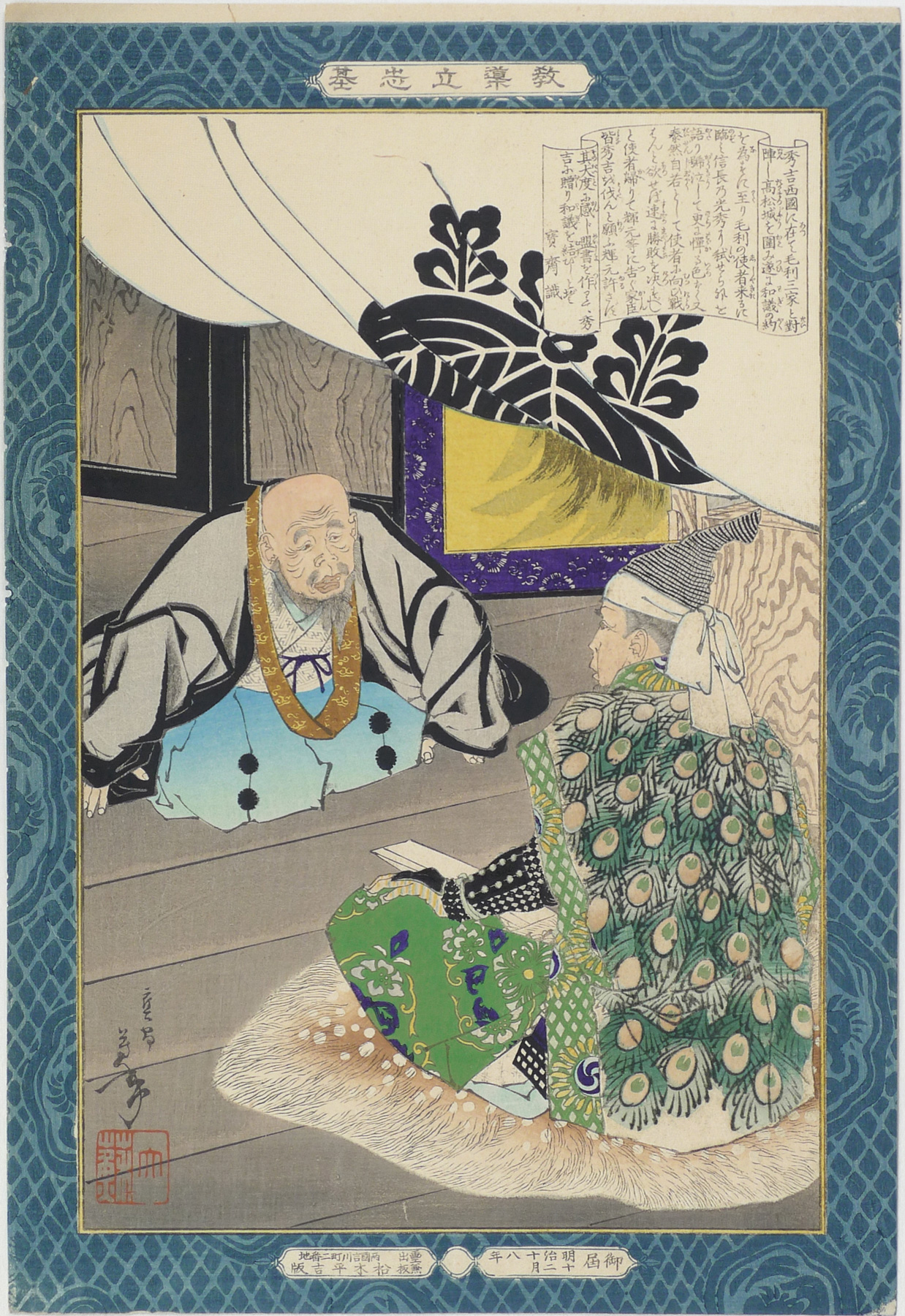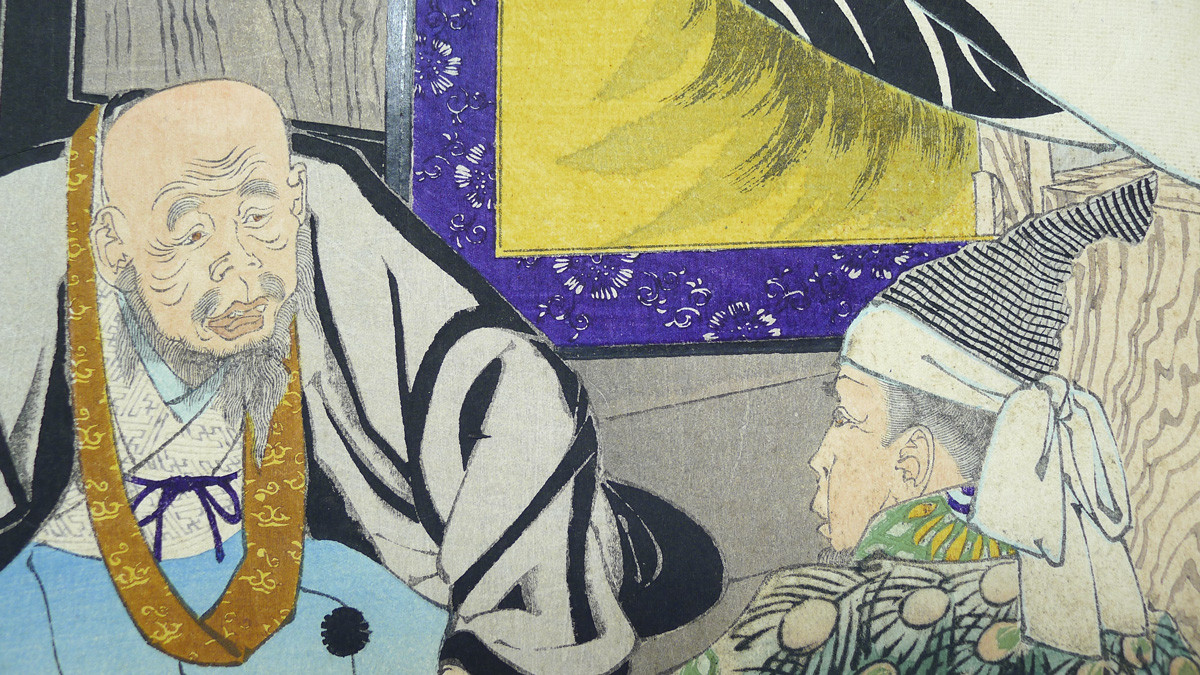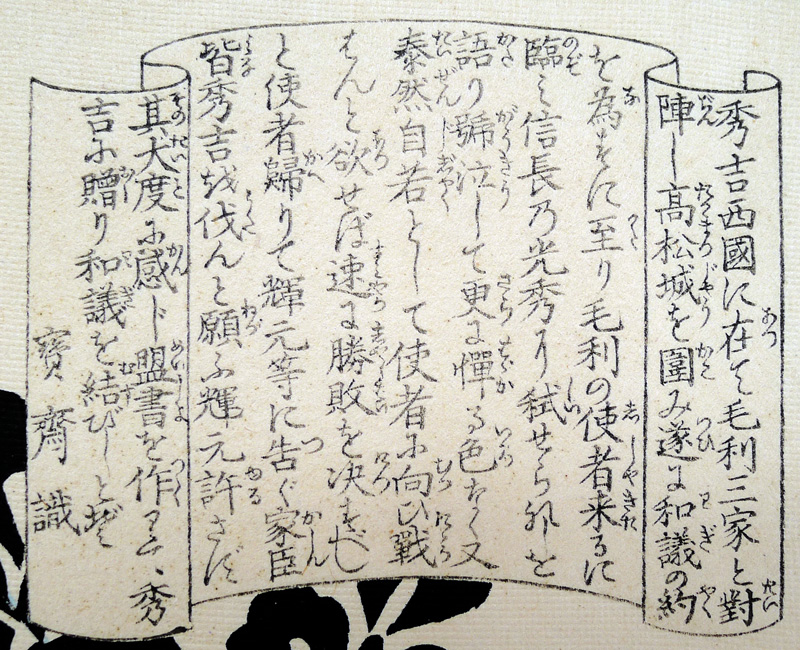About This Print
Print number 三十三 (33)1 in the series Instructive Models of Lofty Ambition picturing Toyotomi Hideyoshi (Hashiba Hideyoshi) seated on a tiger skin and wearing a peacock robe, discussing with a priest the terms of a truce with the rival Mōri clan.1 Numbering of the prints was haphazard during the production of the series. Print numbers were sometimes inadvertently omitted, as they were on this print; some prints in the series were never assigned numbers and a few of the same numbers appear on different prints.
click on image to enlarge
The Story
Sources: A History of the Japanese People from the Earliest Times to the End of the Meiji Era, Frank Brinkley and Dairoku Kikuchi, Nabu Press, 2010 (originally 1915, The Encyclopedia Britannica Co.), p. 491; War in Japan 1467-1615, Stephen Turnbull, Osprey Publishing, 2002, p. 53-57.Background
Hashiba Hideyoshi (羽柴秀吉 1536-1598) is known as one of the Three Unifiers of Japan (三英傑), along with Nobunaga Oda (織田 信長1534-1582) and Ieyasu Tokugawa (1543-1616), who helped bring an end to a long period of war known as the Sengoku period (戦国時代 Sengoku jidai?) or Warring States period, culminating in the Tokugawa Shogunate (1603-1868).
“By 1582 Oda Nobunaga controlled most of central Japan, including Kyoto and the strategic Tokaido and Nakasendo roads to the east. Ishiyama Honganji, the fortified cathedral of the Ikko-ikki, had been taken in 1580, after which triumph Nobunaga had begun to extend his influence westwards for the first time. Two of his most skilled and experienced generals thus began separate but parallel campaigns in this direction. Toyotomi Hideyoshi (who was then called Hashiba Hideyoshi) started the pacification of the southern coast of western Honshu on the Inland Sea, while his comrade in arms, Akechi Mitsuhide [明智 光秀, 1528? - 1582] pursued similar goals on the northern edge of the Sea of Japan.”
In the summer of 1582, Nobunaga fell victim to the treachery of Akechi Mitsuhide, who declared himself the new shogun. At the same time, Hideyoshi was laying siege to Takamatsu Castle, the seat of the Mōri clan, against whom Hideyoshi had waged a six year campaign. During the siege word reached Hideyoshi of Nobunaga's death.
Rather than continuing with the siege, Hideyoshi negotiated a peace with Mōri Terumoto (毛利 輝元, 1553 – 1625), allowing him to march his “army back to Kyoto to avenge his dead master, an act that would... bestow upon him an enormous moral superiority over the treacherous Akechi Mitsuhide…." Taking Mitsuhide by complete surprise Hideyoshi quickly defeated him. Mitsuhide, shogun for 13 days, was eventually murdered by a peasant gang.
The Scene in the Print
It is early June 1582 and a priest, [likely Ankokuji Ekei (安國寺 惠瓊, 1539 – November 6, 1600)]1, is meeting with Hideyoshi, seated on a tiger skin rug and wearing a peacock robe, to discuss peace with the Mori clan, whose Takamatsu Castle is under siege by Hideyoshi. Depending on the account, the priest has either been dispatched by Mōri to sue for peace or summoned by Hideyoshi to bring a peace proposal to Mōri. Prior to the scene pictured, Hideyoshi has intercepted a messenger sent by Mitsuhide to tell Mori of Nobunaga’s death.
A great deal of historical confusion envelops immediately subsequent events, but the facts seem simple enough. Hideyoshi found himself in a position of great difficulty. His presence in Kyoto was almost a necessity, yet he could not withdraw from Takamatsu without sacrificing all the fruits of the campaign in the west and exposing himself to a probably disastrous attack by Mori's army. In this emergency he acted with his usual talent. Summoning a famous priest, Ekei, of a temple in Aki, who enjoyed the confidence of all parties, he despatched him to Mori 's camp with proposals for peace and for the delimitation of the frontiers of Mori and Nobunaga, on condition that the castle of Takamatsu should be surrendered and the head of its commander, Shimizu Muneharu, presented to his conquerer.
Mori was acting entirely by the advice of his two uncles, Kikkawa and Kohayakawa, both men of profound insight. They fully admitted the desirability of peace, since Hideyoshi 's army effectually commanded the communications between the eastern and western parts of Chugoku, but they resolutely rejected the notion of sacrificing the life of Shimizu on the altar of any compact. When the priest carried this answer to Hideyoshi, the latter suggested, as the only recourse, that Shimizu himself should be consulted. Ekei accordingly repaired to the castle and explained the situation to its commandant. Shimizu had not
a moment's hesitation. He declared himself more than willing to die for the sake of his liege-lord and his comrades, and he asked only that fish and wine, to give the garrison the rare treat of a good meal, should be furnished. On the 5th of the sixth month this agreement was carried into effect. Shimizu committed suicide the compact between Mori and Hideyoshi was signed, and the latter, striking his camp, prepared to set out for Kyoto. It was then for the first time that Mori and his generals learned of the death of Nobunaga. Immediately there was an outcry in favour of disregarding the compact and falling upon the
enemy in his retreat; but Kikkawa and Kohayakawa stubbornly opposed anything of the kind. They declared that such a course would disgrace the house of Mori, whereas, by keeping faith, the friendship of Hideyoshi and his fellow barons would be secured. Accordingly the withdrawal was allowed to take place unmolested.
1 Note that I do not believe Ankokuji’s name appears in the scroll.
Transcription of Scroll
Source: with thanks to Yajifun http://yajifun.tumblr.com/click on scroll to enlarge
33 Hashiba Hideyoshi 羽柴秀吉
教導立志基 三十三 羽柴秀吉 月岡芳年 1885年12月
Transcription:
“秀吉西國に在て毛利三家と對陣(対陣)し高松城を圍(囲)み遂に和議の約を為すに至り毛利の使者来るに臨ミ信長乃光秀に弑せられしを語り號泣(号泣)して更に憚る色なく又泰然自若として使者に向ひ戰(戦)わんと欲せば速に勝敗を決すべしと 使者歸(帰)りて輝元等に告ぐ 家臣皆秀吉を伐んと願ふ 輝元許さず其大度に感じ盟書を作りて秀吉に贈り和議を結びしとぞ 宝斎 識”
About The Series "Kyōdō risshi no motoi"Notes:1. This series is variously translated as "Instructive Models of Lofty Ambition," "Foundations of Learning and Achievement," "Foundation of Instruction and Perseverance," "Self-Made Men Worthy of Emulation," "Paragons of Instruction and Success," "Moral of Success," "Examples of Self-Made Leaders," and "Instruction in the Fundamentals of Success." The title in Japanese is sometimes seen as "Kyōdō risshiki or "Kyōdō risshi no moto," in addition to the most commonly seen transliteration of "Kyōdō risshi no motoi".2. For a complete listing of all the prints in the series and additional information please see the article on this site titled Instructive Models of Lofty Ambition.
This series ran between October 1885 and November 1890 and featured a long list of heroes and heroines, from antiquity to contemporary times, who were regarded as standards of moral leadership and self-realization.
Source: Kiyochika Artist of Meiji Japan, Henry D. Smith II, Santa Barbara Museum of Art, 1988, p. 74-75; original research and as footnoted.
This series of 58 prints,1 plus a table of contents sheet (目録), were originally published between October 1885 and November 1890 by the Tokyo publisher Matsuki Heikichi 松木平吉.2 The table of contents sheet issued by the publisher states that "fifty prints make up the complete set (五十番揃)". Three prints not in the initial release were added over the five year publication period, as were five redesigns of original prints, eventually increasing the total print count to 58. The seven artists contributing prints were Kobayashi Kiyochika (1847-1915) [20 prints], Mizuno Toshikata (1866-1908) [16 prints], Inoue Tankei (Yasuji) (1864-1889) [13 prints], Taiso (Tsukioka) Yoshitoshi (1839-1892) [5 prints], Yōshū Chikanobu (1838-1912) [2 prints], Toyohara Kunichika (1835–1900) [1 print], and Hachisuka (Utagawa) Kuniaki II (1835-1888) [1 print]. All the artists, with the exception of Yōshū Chikanobu, are listed in the top scroll of the table of contents sheet. Various colors (including blue, blue/green, and tan/brown) were used for the decorative border, and in 1902 the series was re-issued by Matsuki without borders.
Brief texts contained within a scroll-like cartouche appearing on each print provide historical details. The scroll composer's name is given at the end of the scroll text. The “lofty ambition” of the title is a Confucian concept, originally from Mencius, meaning “righteous determination that would inspire others.” The market for the series probably included former samurai, ambitious youth, and conservative intellectuals.
"[W]hen it was completed in 1890 the publisher was singled out for special recognition by the government for having sponsored such noble subject matter."3
1. This series is variously translated as "Instructive Models of Lofty Ambition," "Foundations of Learning and Achievement," "Foundation of Instruction and Perseverance," "Self-Made Men Worthy of Emulation," "Paragons of Instruction and Success," "Moral of Success," "Examples of Self-Made Leaders," and "Instruction in the Fundamentals of Success." The title in Japanese is sometimes seen as "Kyōdō risshiki or "Kyōdō risshi no moto," in addition to the most commonly seen transliteration of "Kyōdō risshi no motoi".
2. For a complete listing of all the prints in the series and additional information please see the article on this site titled Instructive Models of Lofty Ambition.
This series ran between October 1885 and November 1890 and featured a long list of heroes and heroines, from antiquity to contemporary times, who were regarded as standards of moral leadership and self-realization.
Source: Kiyochika Artist of Meiji Japan, Henry D. Smith II, Santa Barbara Museum of Art, 1988, p. 74-75; original research and as footnoted.
This series of 58 prints,1 plus a table of contents sheet (目録), were originally published between October 1885 and November 1890 by the Tokyo publisher Matsuki Heikichi 松木平吉.2 The table of contents sheet issued by the publisher states that "fifty prints make up the complete set (五十番揃)". Three prints not in the initial release were added over the five year publication period, as were five redesigns of original prints, eventually increasing the total print count to 58. The seven artists contributing prints were Kobayashi Kiyochika (1847-1915) [20 prints], Mizuno Toshikata (1866-1908) [16 prints], Inoue Tankei (Yasuji) (1864-1889) [13 prints], Taiso (Tsukioka) Yoshitoshi (1839-1892) [5 prints], Yōshū Chikanobu (1838-1912) [2 prints], Toyohara Kunichika (1835–1900) [1 print], and Hachisuka (Utagawa) Kuniaki II (1835-1888) [1 print]. All the artists, with the exception of Yōshū Chikanobu, are listed in the top scroll of the table of contents sheet. Various colors (including blue, blue/green, and tan/brown) were used for the decorative border, and in 1902 the series was re-issued by Matsuki without borders.
This series of 58 prints,1 plus a table of contents sheet (目録), were originally published between October 1885 and November 1890 by the Tokyo publisher Matsuki Heikichi 松木平吉.2 The table of contents sheet issued by the publisher states that "fifty prints make up the complete set (五十番揃)". Three prints not in the initial release were added over the five year publication period, as were five redesigns of original prints, eventually increasing the total print count to 58. The seven artists contributing prints were Kobayashi Kiyochika (1847-1915) [20 prints], Mizuno Toshikata (1866-1908) [16 prints], Inoue Tankei (Yasuji) (1864-1889) [13 prints], Taiso (Tsukioka) Yoshitoshi (1839-1892) [5 prints], Yōshū Chikanobu (1838-1912) [2 prints], Toyohara Kunichika (1835–1900) [1 print], and Hachisuka (Utagawa) Kuniaki II (1835-1888) [1 print]. All the artists, with the exception of Yōshū Chikanobu, are listed in the top scroll of the table of contents sheet. Various colors (including blue, blue/green, and tan/brown) were used for the decorative border, and in 1902 the series was re-issued by Matsuki without borders.
Brief texts contained within a scroll-like cartouche appearing on each print provide historical details. The scroll composer's name is given at the end of the scroll text. The “lofty ambition” of the title is a Confucian concept, originally from Mencius, meaning “righteous determination that would inspire others.” The market for the series probably included former samurai, ambitious youth, and conservative intellectuals.
"[W]hen it was completed in 1890 the publisher was singled out for special recognition by the government for having sponsored such noble subject matter."3
1 The Tokyo Metropolitan Library online collection shows 50 prints and a Table of Contents sheet. The Table of Contents lists the titles of 50 prints. Smith in Kiyochika Artist of Meiji Japan identified 52 prints. I have identified 58 prints from this series including five prints (Ikina, Michizane Sugiwara, Kesa Gozen, Soga Brothers and Hokiichi Hanawa) that were re-designed and re-printed, likely due to damaged or lost blocks.
2 Robert Schaap notes in Appendix II, p. 166 of Yoshitoshi, Masterpieces from the Ed Freis Collection, Chris Uhlenbeck and Amy Reigle Newland, Hotei Publishing, 2011 that the series originally appeared as newspaper supplements.
3 The World of the Meiji Print: Impressions of a New Civilization, Julia Meech-Pekarik, Weatherhill, 1986, p. 122.
1 The Tokyo Metropolitan Library online collection shows 50 prints and a Table of Contents sheet. The Table of Contents lists the titles of 50 prints. Smith in Kiyochika Artist of Meiji Japan identified 52 prints. I have identified 58 prints from this series including five prints (Ikina, Michizane Sugiwara, Kesa Gozen, Soga Brothers and Hokiichi Hanawa) that were re-designed and re-printed, likely due to damaged or lost blocks.
2 Robert Schaap notes in Appendix II, p. 166 of Yoshitoshi, Masterpieces from the Ed Freis Collection, Chris Uhlenbeck and Amy Reigle Newland, Hotei Publishing, 2011 that the series originally appeared as newspaper supplements.
3 The World of the Meiji Print: Impressions of a New Civilization, Julia Meech-Pekarik, Weatherhill, 1986, p. 122.
Print Details
| IHL Catalog | #712 |
| Title or Description | Hashiba Hideyoshi 羽柴秀吉 |
| Series | “Instructive Models of Lofty Ambition” (Kyodo risshiki 教導立志基) [note: seriestitle also listed as 'Kyodo Risshi no Moto', ‘Kyodo risshi no motoi’,‘Kyōdō risshi ki’ and variously translated as “Moral of success” or“Foundations of learning and achievement” or “Self-made Men Worthy ofEmulation”' or “Examples of Self-made Leaders” or "Paragons of instruction and success"] |
| Artist | Tsukioka Yoshitoshi (1839-1892) |
| Signature |  |
| Seal | Taiso 大蘇 [as shown above below signature] |
| Publication Date | December 1885 明治十八年 十二月 |
| Publisher | Matsuki Heikichi (松木平吉) proprietor of Daikokuya Heikichi [Marks: seal not shown; pub. ref. 029] click to enlarge (from right to left) publishing and printing date: 御届 明治十八年 十二月 [notification delivered, Meiji 18th year 12th month] assigned number within series: blank [三十三 on other impressions] publisher information: 画工兼 出版 両国吉川町二番地 松木平吉 版 [artist and publisher Ryōgoku Yoshikawachō 2-banchi Matsuki Heikichi han] |
| Carver | |
| Impression | excellent |
| Colors | excellent |
| Condition | excellent |
| Genre | ukiyo-e; rishki-e; kyōiku nishiki-e |
| Miscellaneous | scroll text by Hōsai 宝斎 識 print number 33 ([三十三); position 33 in the Table of Contents for the series |
| Format | vertical oban |
| H x W Paper | 14 5/8 x 9 7/8 in. (37.1 x 25.1 cm) |
| Literature | |
| Collections This Print | The Tsubouchi Memorial Theatre Museum of Waseda University 201-3019; Tokyo Metropolitan Library 280-K28 |





